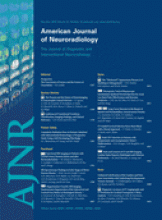Abstract
BACKGROUND AND PURPOSE: ICAS is one of the therapeutic options in symptomatic cerebral artery stenosis. iaDSA is the current criterion standard examination after ICAS for the detection of ISR. In this study, we evaluated ivACT as a potential noninvasive follow-up alternative.
MATERIALS AND METHODS: In 17 cases, ivACT and iaDSA were performed after ICAS. Both procedures were carried out on a flat-panel-detector-equipped angiography system. Postprocessing of ivACT acquisitions was performed on a dedicated workstation producing multiplanar reformations of the stent region and other intracranial arteries. Restenotic lesions were compared with iaDSA measurements. All studies were independently evaluated by 2 experienced neuroradiologists blinded to patients data.
RESULTS: In 5 cases, ISR was diagnosed on iaDSA images. All restenotic lesions were reliably detected (sensitivity, 100%; 95%CI, 48%–100%) and could be correctly quantified on ivACT images in comparison with iaDSA. The neuroradiologists correctly excluded ISR in 11 of 12 lesions after viewing the ivACT examinations (specificity, 92%; 95%CI, 62%–100%). Measurements of ISR on ivACT were highly correlated to iaDSA (Pearson r = 0.94, P < .01).
CONCLUSIONS: IvACT is a promising noninvasive follow-up examination after ICAS. With its high spatial resolution, it can reliably detect or exclude ISR. Contrary to iaDSA, there is no need for a recovery period after ivACT and the risk of neurologic complications is practically lowered to zero.
Abbreviations
- A2
- second segment of anterior cerebral artery
- ACT
- angiographic CT
- BA
- basilar artery
- C3
- third segment of ICA
- CI
- confidence interval
- CTDIw
- weighted CT dose index
- ΔDSA%
- change of stenosis percentage at follow-up iaDSA compared with measurements on iaDSA after stenting
- DSApost
- digital subtraction angiography after stenting
- DSApre
- digital subtraction angiography before stenting
- DWI
- diffusion-weighted imaging
- IA
- focal lesion involving the end of the stent
- iaDSA
- intra-arterial digital subtraction angiography
- IB
- focal lesion involving the body of the stent
- IC
- multiple restenotic foci involving <50% of the stented segment
- ICA
- internal carotid artery
- ICAS
- intracranial artery angioplasty and stenting
- II
- diffuse intrastent lesion
- ISR
- in-stent restenosis
- ivACT
- ACT after intravenous contrast medium application
- M1
- first segment of middle cerebral artery
- MDCTA
- multidetector CT angiography
- PTA
- percutaneous transluminal angioplasty
- rePTA
- repeated PTA after ICAS
- TIA
- transient ischemic attack
- V4
- intracranial segment of vertebral artery
- Copyright © American Society of Neuroradiology











